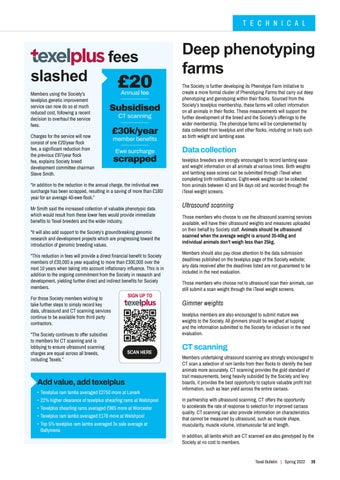T E C H N I C A L
slashed Members using the Society’s texelplus genetic improvement service can now do so at much reduced cost, following a recent decision to overhaul the service fees.
fees
£20 Annual fee
Subsidised
Charges for the service will now consist of one £20/year flock fee, a significant reduction from the previous £97/year flock fee, explains Society breed development committee chairman Steve Smith.
CT scanning
£30k/year member benefits Ewe surcharge
scrapped
“In addition to the reduction in the annual charge, the individual ewe surcharge has been scrapped, resulting in a saving of more than £180/ year for an average 40-ewe flock.” Mr Smith said the increased collection of valuable phenotypic data which would result from these lower fees would provide immediate benefits to Texel breeders and the wider industry. “It will also add support to the Society’s groundbreaking genomic research and development projects which are progressing toward the introduction of genomic breeding values. “This reduction in fees will provide a direct financial benefit to Society members of £30,000 a year equating to more than £300,000 over the next 10 years when taking into account inflationary influence. This is in addition to the ongoing commitment from the Society in research and development, yielding further direct and indirect benefits for Society members. For those Society members wishing to take further steps to simply record key data, ultrasound and CT scanning services continue to be available from third party contractors. “The Society continues to offer subsidies to members for CT scanning and is lobbying to ensure ultrasound scanning charges are equal across all breeds, including Texels.”
SIGN UP TO
Deep phenotyping farms The Society is further developing its Phenotype Farm Initiative to create a more formal cluster of Phenotyping Farms that carry out deep phenotyping and genotyping within their flocks. Sourced from the Society’s texelplus membership, these farms will collect information on all animals in their flocks. These measurements will support the further development of the breed and the Society’s offerings to the wider membership. The phenotype farms will be complemented by data collected from texelplus and other flocks, including on traits such as birth weight and lambing ease.
Data collection texelplus breeders are strongly encouraged to record lambing ease and weight information on all animals at various times. Birth weights and lambing ease scores can be submitted through iTexel when completing birth notifications. Eight-week weights can be collected from animals between 42 and 84 days old and recorded through the iTexel weight screens.
Ultrasound scanning Those members who choose to use the ultrasound scanning services available, will have their ultrasound weights and measures uploaded on their behalf by Society staff. Animals should be ultrasound scanned when the average weight is around 35-40kg and individual animals don’t weigh less than 25kg. Members should also pay close attention to the data submission deadlines published on the texelplus page of the Society website; any data received after the deadlines listed are not guaranteed to be included in the next evaluation. Those members who choose not to ultrasound scan their animals, can still submit a scan weight through the iTexel weight screens.
Gimmer weights texelplus members are also encouraged to submit mature ewe weights to the Society. All gimmers should be weighed at tupping and the information submitted to the Society for inclusion in the next evaluation.
SCAN HERE
Add value, add texelplus • Texelplus ram lambs averaged £2750 more at Lanark • 22% higher clearance of texelplus shearling rams at Welshpool • Texelplus shearling rams averaged £865 more at Worcester • Texelplus ram lambs averaged £178 more at Welshpool • Top 5% texelplus ram lambs averaged 3x sale average at Ballymena
CT scanning Members undertaking ultrasound scanning are strongly encouraged to CT scan a selection of ram lambs from their flocks to identify the best animals more accurately. CT scanning provides the gold standard of trait measurements, being heavily subsided by the Society and levy boards, it provides the best opportunity to capture valuable profit trait information, such as lean yield across the entire carcass. In partnership with ultrasound scanning, CT offers the opportunity to accelerate the rate of response to selection for improved carcass quality. CT scanning can also provide information on characteristics that cannot be measured by ultrasound, such as muscle shape, muscularity, muscle volume, intramuscular fat and length. In addition, all lambs which are CT scanned are also genotyped by the Society at no cost to members.
Texel Bulletin | Spring 2022
39







